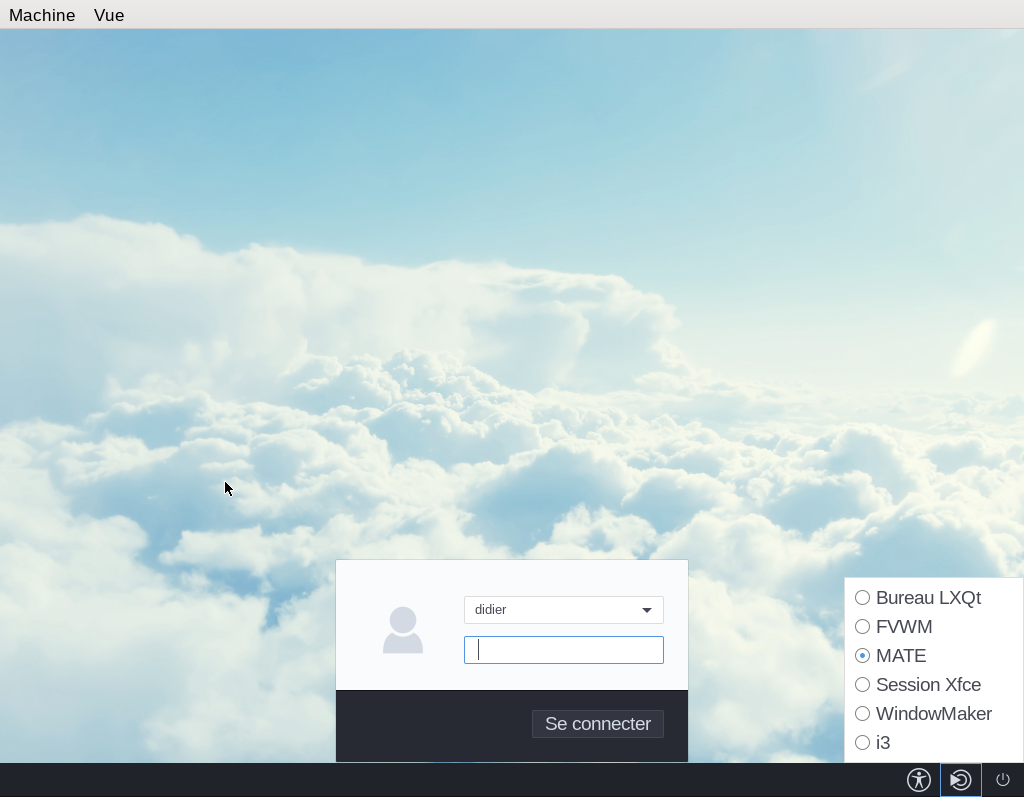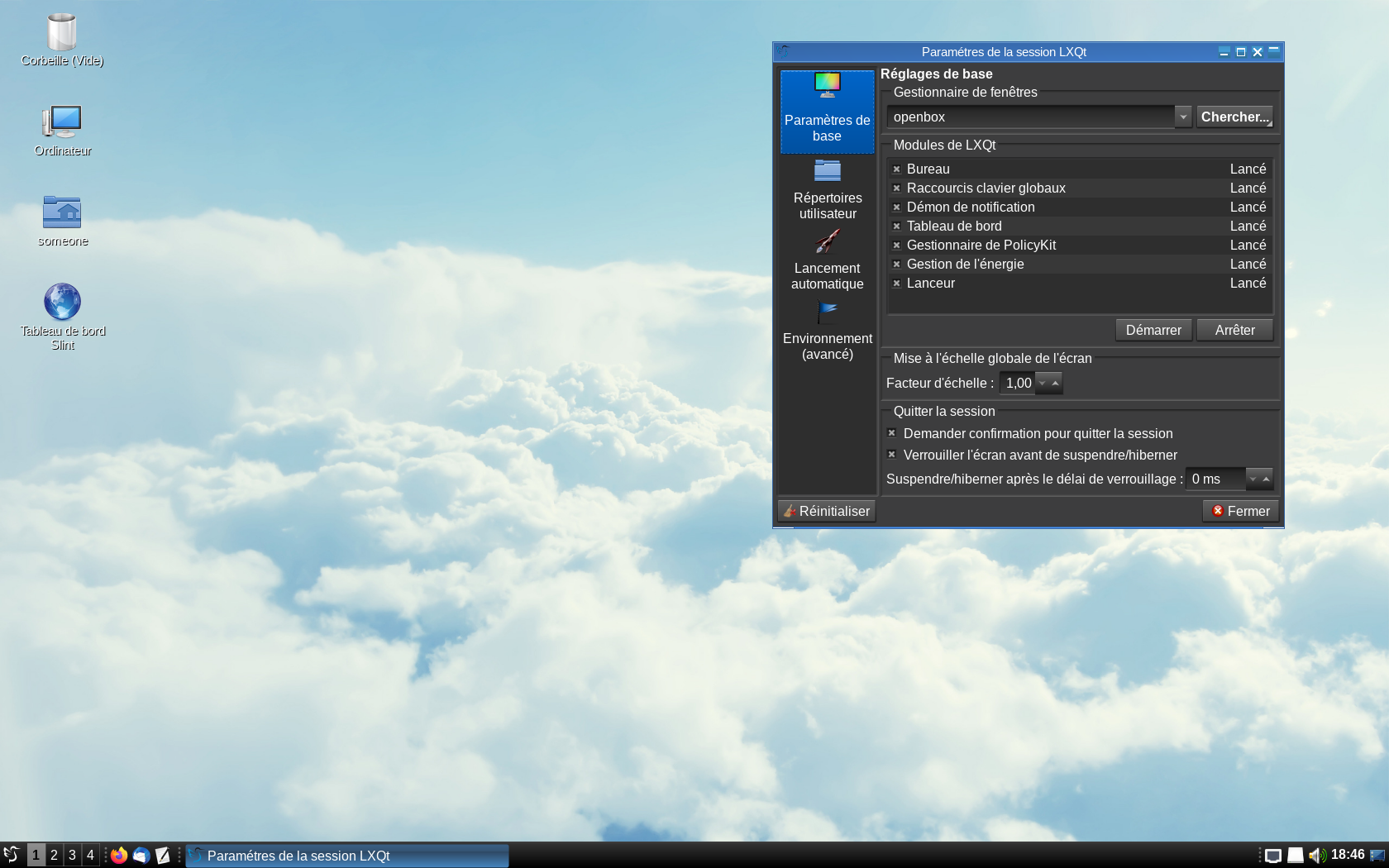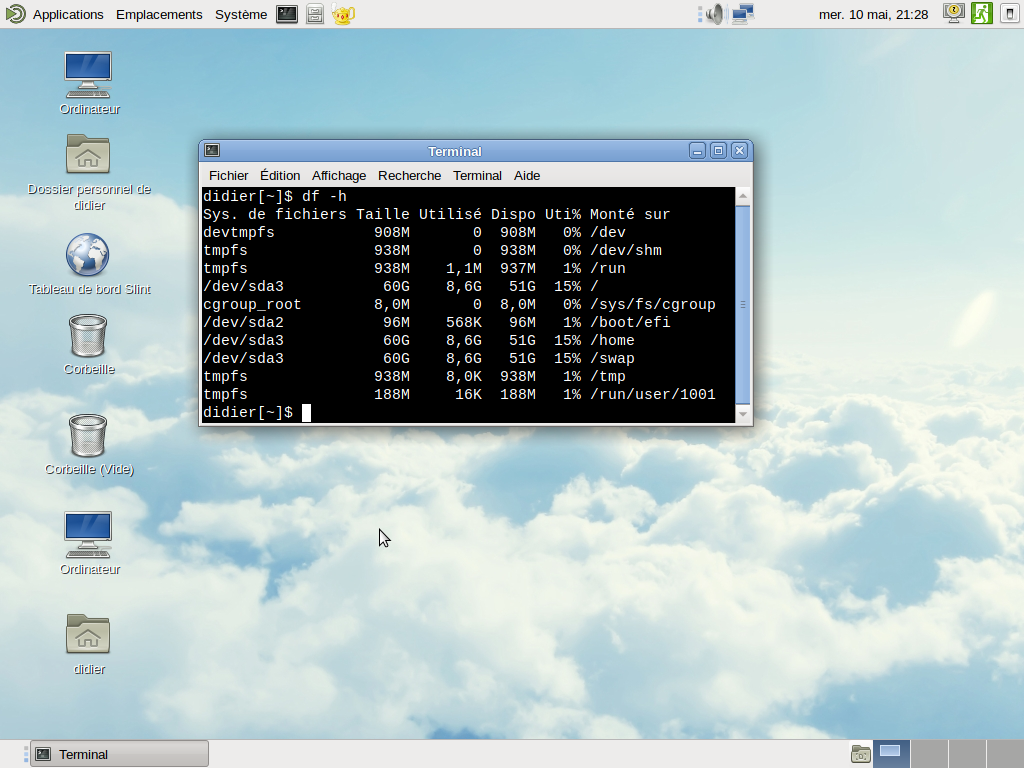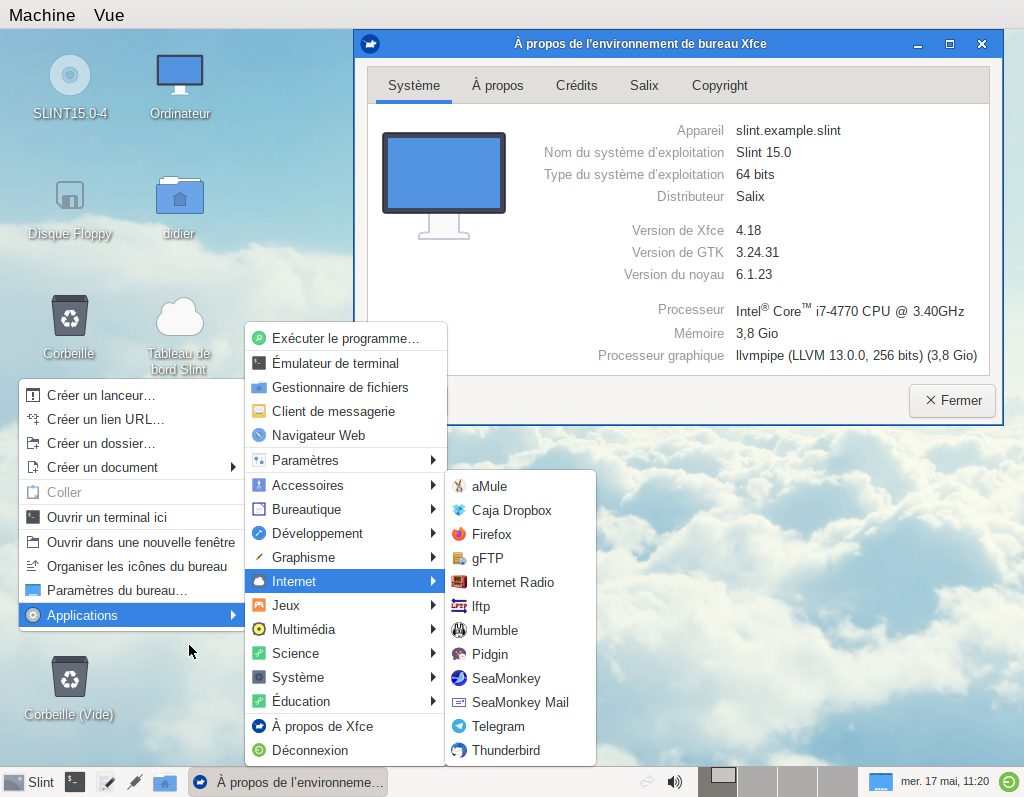1. News
1.1. 20 June 2024: Updates preparing the release of a new ISO
The batch of updates available today paves the way for a new ISO that will, beyond these updates and a few fixes of the installer, provide only one desktop: MATE.
Other desktops will be available, either provided in other ISOs, or installable as packages sets provided by contributors, at least the XFCE and LXQt desktops.
The current batch of updates provides mainly:
-
New versions of the MATE and LXQt desktops
-
An enhancement of the visual appearance of the MATE desktop, huge thanks to miss Tell for her many hints and suggestions!
-
An upgrade of several a11y applications to their latest stable versions
-
New and upraded packages in the main repository, /testing or /extra.
The changes are detailed in the Changelog
Before listing the major ones, here is how to make existing desktops look as if they had been installed after the upgrade.
If you want to re-configure MATE to get its new appearance for a given user, just type as this user: dconf reset -f /
Be aware that this will override the customization that you’d have previously done at the user level!
If you want to reconfigure LXQt to get its new appearance for a given user, you need to first get out of LXQt. Either type as root login-chooser text then reboot, or log in another desktop like MATE. Then type as regular user:
rm ~/.config/lxqt/*.conf
cp /usr/share/pcmanfm-qt/lxqt/settings.conf ~/.config/lxqt/
Again, be aware that this will override the customization that you’d have previously done at the user level!
1.1.1. The MATE desktop and the graphical login manager
-
The Mate Control Center is customized for Slint.
-
The Mate tweak application is customized for Slint. It includes several layouts of the panels, including Slint-legacy (the previous layout) and Slint (the new one).
-
The Slint layout provides a single panel including a Brisk menu giving a direct access to several utilities. 3 other menus are available: Advanced, Classic (the default for Slint-legacy) and Compact. In the Slint layout pressing alt-f1 now raises the Compact menu with a single column. In the Slint-legacy layout pressing alt-F1 still raises the Classical menu.
-
The Brisk menu includes at the bottom links to the Slint documentation and mate-tweak and a Favorite area, with by default the Caja file manager, the Mate terminal, Firefox, Thuderbird and the Mate Control Center
-
The default window manager for Mate is now Compiz whith an Emerald theme that can be changed using the custom script switch-emerald-theme. But Marco is still available. The change can be made in mate-tweak. In addition to the CCSM (compiz-config-settings-manager), simple-ccsm is provided in /extra.
-
The lightdm-gtk-greeter is replaced by the lightdm-slick-greeter.
The file /usr/share/glib-2.0/schemas/10.slint-appearance.gschema.override gathers customization of the Mate desktop and some other ones at the distribution level.
1.1.2. The LXQt desktop
This desktop is provided running build scripts provided by Frank Honolka aka snuk, and stored in the lxqt sub-directory, thanks Frank!
This includes the desktop itself and associated applications.
As for Mate the default window manager is compiz and the decorator emerald but openbox is also available. The window manager can be changed from the menu or typing lxqt-config-session
1.1.3. Other upgrades and new software provided, sorted by category
-
Acessibility: at-spi2-core, orca, emacspeak, fenrir, liblouis, liblouisutdml and lios are upgraded.
-
Audio/video: vlc, mpv and yt-dlp are upgraded.
-
The semantic application launchers cerebro, synapse and ulauncher are provided in /testing. A short presentation of them can be found for instance in https://www.debugpoint.com/top-ubuntu-launcher-2022/ and https://softwarelibre166246735.wordpress.com/2020/06/18/10-best-application-launchers-for-linux-desktops/. These launchers allow to start applications but also to find files in your system, do calculations or search the web, for instance, often through plugs-ins.
-
Visual appearance: many themes are added or upgraded: Qogir-icon-theme, emerald-themes (the "overglossed" theme of the emerald decorator is associated with the Compiz window manager), kvantum-theme-qogir, breeze-blue-cursor-theme and breeze-icons for LXQt, papirus-icon-theme, yaru-gtk-theme. Newaita-reborn, posy-cursors and Tela-icon-theme are also available in /testing. Conversely, mate-colors-icon-teme, mate-backgrounds and murrine-themes are removed. Several desktop backgrounds or wallpapers are added.
-
System: btrtbk (backup tool for BTRFS subvolumes) and sof-firmware are added, absm (BTRFS snashot manager), amd-microcode, intel-microcode, kernel, kernel-firmware, and qemu (in /extra) are upgraded. The guake drop-down terminal is added
-
Development: vscode (Visual Studio Code) is added in /extra, nano and emacs are upgraded.
-
Office: LibreOffice and associated help files and dictionaries are upgraded, thanks to Eric Hameleers aka alienBOB and libreoffice-sdkdoc is available in /extra. Remind is also updated.
1.1.4. Known issues
-
After upgrade LXQt can have a black background because the previous default wallpaper has been removed. You can choose another one typing
lxqt-config-appearance, that can also be started form the menu or a left click on the desktop. Alternatively, as indicated above type after a text login:cp /usr/share/pcmanfm-qt/lxqt/settings.conf ~/.config/lxqt/. This will display the new default wallpaper. -
In MATE if started in text mode the date can’t be set using the widget in the boottom panel. Use clocksetup or gtkclocksetup instead.
-
If you disable the display of the desktop icons in mate-tweak, a right click on the desktop becomes ineffective.
1.2. 16 May 2023: A new ISO is available (yes, again!)
This new ISO is provided mainly to fix the bug described in BUG-15.0-3.
Other fixes and enhancements:
-
The user who refuses the proposed (through geoIP) time zone is given the choice to select another one or keep the default one (UTC), as if none were proposed.
-
The EFI boot loader grub.x64.efi is installed in /boot/efi/EFI/slint-$SLINTVERSION, currently /boot/efi/EFI/slint-15.0, to help select the boot entry if several versions are installed.
In case of manual partitioning:
-
If the machine booted the installer in Legacy mode GRUB is also installed in EFI mode if an EFI System Partition (ESP) is found on the drive of the root partition.
-
If the machine booted the installer in EFI mode GRUB is also installed in Legacy mode unless the root partition be in a drive with a GUID partition table (GPT) but with no BIOS boot partition.
Thus, in most cases the installed system will be able to boot in both EFI and Legacy modes in manual as in auto partitioning modes.
1.3. 10 May 2023: A new Slint ISO is available
-
The lightweight i3 desktop is added as well as the I38 utility which make it fully accessible with a screen reader, just running the i38 command after installation, thanks to Storm Dragon.
-
The repository xfce4.18-15.0 is enabled by default, allowing to install a fully configured and featured xfce-4.18 desktop just typing
slapt-get --install-set xfce, thanks to George Vlahavas. -
In
manualpartitioning mode it is no more required to include a BIOS Boot partition in a GUID partition table (GPT) if the machine booted in EFI mode, nor an EFI System partition if the machine booted in Legacy mode. -
In
autopartitioning mode it is now allowed to put the /home directory in dedicated partition, only if it is in another drive than the one hosting the main partition mounted as /. -
The user is allowed to select an existing partition for /home, possibly to continue using an existing one.
-
If /home is in an already formatted partition (in case the user wants to continue using an existing one), the installer will offer to keep its content or re-format it, as with any other linux partition except the main one mounted as /.
-
All main desktops (MATE, LXQt, Xfce) as the lightDM greeting screen have the same background "clouds in a blue sky".
-
A lot of packages have been added, upgraded or fixed since the release of the previous ISO, some of the added ones included in the ISO,among which: compsize, confuse, fim, gpart, nushell, Qogir-icon-theme, qogir-theme, salix-xfwm4-theme, rust, testdisk, others available in the /extra repository: calibre, emacs-nativecomp, libgccjit, notmuch, soft.
-
The boot menu of the installed system include a menu entry to access the firmware’s setup in EFI mode.
-
If GRUB is installed it is now possible to boot the installation ISO stored in an internal disk’s partition: no need to write this ISO on a DVD or USB stick in this case. To do so, edit the file /etc/grub.d/40_custom so it contains:
#!/bin/sh
exec tail -n +3 $0
# This file provides an easy way to add custom menu entries. Simply type the
# menu entries you want to add after this comment. Be careful not to change
# the 'exec tail' line above.
menuentry 'Slint ISO 15.0-3' {
insmod part_gpt
insmod part_msdos
search --no-floppy --fs-uuid --set=root <UUID>
set isofile='slint64-15.0-3.iso'
loopback loop /repo/x86_64/slint-15.0/iso/$isofile
linux (loop)/linux quiet vga=normal load_ramdisk=1 prompt_ramdisk=0 ro printk.time=0
initrd (loop)/initrd
}
Just replace <UUID> by the UUID of the partition where the ISO is stored. For instance if the ISO is in /dev/sda3, this command will output this UUID: lsblk -lno uuid /dev/sda3. Also replace /repo/x86_64/slint-15.0/iso/ by the path to the ISO file. After that, run grub-mkconfig or update-grub so that this boot entry be included in grub.cfg. The installer will tell you it can’t find the ISO and how to mount it if it is in an internal disk’s partition.
1.3.1. Pictures of lightDM and the main desktops in Slint
lightDM

LXQt

MATE

XFCE (installed on demand)
